How a Couple of Guys Built the Most Ambitious Alien Outreach Project Ever
You might think it takes vast governmental resources to launch an extraterrestrial communication effort. Nope
:focal(1835x917:1836x918)/https://tf-cmsv2-smithsonianmag-media.s3.amazonaws.com/filer/95/cc/95cc26f3-7c3a-43be-9e8d-e5224df08962/telescope.jpg)
On May 24, 1999, a large radio transmitter in the city of Evpatoria in Ukraine turned its dish to the star 16 Cygni, 70 light-years away, and emitted a four-hour blast of radio waves. It was the beginning of the Cosmic Call, one of the most ambitious efforts ever made at sending a message to alien civilizations. It wasn’t a project run by NASA or some major government. It was a crowdsourced effort, put together by an unlikely team of Texan businessmen, Canadian astrophysicists, Russian scientists, and Eastern European radio engineers.
It was the brainchild of Charlie Chafer, the CEO of a Texan company named Team Encounter. Team Encounter hoped to launch a prototype solar sail, that is, a spacecraft driven by the pressure of sunlight. Its trajectory would take it out of the solar system altogether. It wouldn’t be fast, taking 100,000 years just to go as far as the nearest star. Chafer wanted it to carry a three-kilogram payload with messages, photographs, and DNA samples to show any alien finders what life on Earth is, or was, like.
But 100,000 years is a long time to wait. So Chafer also decided to send a radio message to various nearby stars with drawings, texts, and songs, many of them from ordinary people. “A sort of ‘we're coming’ announcement,” Chafer says. This became the Cosmic Call. (As it happens, the solar sail never flew, but the Cosmic Call project went forward.)
The Cosmic Call caught the attention of a Canadian astrophysicist named Yvan Dutil. He knew that a radio message would be incomprehensible to extraterrestrials without a preface explaining our number system, the makeup of our planet, the physical shapes and sizes of human bodies, and so on. In short, the message needed a primer. He contacted Chafer. “I said, Guys, I'm an astrophysicist,” Dutil recalls. “I would be pleased to help you to check your messages.”
But Chafer’s team had no idea how to write a primer. Dutil recalls, “They said, Why not write the message yourself?” So Dutil did. He enlisted his friend Stéphane Dumas, also a physicist. Together Dutil and Dumas read Hans Freudenthal's 1960 book Lincos: Design of a Language for Cosmic Intercourse, Part I. They were the only people ever to have checked it out of the local university's library. They soon saw why: “It's the most boring book in the world,” Dutil says. Freudenthal never made it to Part II.
Freudenthal had aimed to create a purely symbolic medium of communication that any species with a basic grasp of logic could understand. The book’s no page-turner. But Dutil and Dumas persevered, and spent six months writing a primer. Then they needed to find a radio transmitter powerful enough to send it. First they asked NASA, which politely turned them down. Dutil got on the Web and started searching for other radio transmitters. “On this webpage was a list of all the radar astronomy experiments done before, and one of those was from Evpatoria in Ukraine,” Dutil says. “I had never heard about that radio telescope. I sent a short email to the guy and said Hey! Do you think your radar would be available for SETI transmission?”
Chafer remembers it differently, with one of his employees hearing about the dish and handling the contract negotiations. (Possibly they both inquired.) Dutil recalls that the ex-Soviets were receptive to the idea: “I guess they were quite happy to get some money to operate these things, because in 1999 Russia had not recovered yet from the post-Soviet Union crash and in those times any money was good, so it was rather easy. Russia was open for business for anything.”
And Alexander Zaitsev, a prominent astronomer at the Russian Academy of Science, was glad to be involved. Zaitsev had used the Evpatoria transmitter for years to study Venus, Mars, Mercury, and several asteroids. But he also had a deep interest in SETI. He agreed to oversee the sending of the Cosmic Call from Ukraine. And with that, a DIY alien outreach project was born.
Zaitsev had to exercise some diplomatic delicacy. In 1999 memories of the Cold War were still fresh, and there were tensions over how the Americans were intervening against the Serbs during the war in the former Yugoslavia. “[Evpatoria] is the middle of nowhere,” Chafer says. “It's a base that was used to track Russian satellites that were used in submarine communications out of Sevastopol. It was a very highly sensitive military base.”
So it was politically awkward for the Cosmic Call team visiting Evpatoria to be led by Americans. But one of Team Encounter’s employees was Romanian, and one of its guests was Danish. So Zaitsev decided that the Cosmic Call team was a Romanian and Danish delegation with two American observers. Chafer recalls, “[Zaitsev] gets the gold star for making it happen. I mean, literally everybody he was dealing with had a uniform on, and here comes this Danish Romanian delegation with two American visitors.”
And that’s how the Cosmic Call team got to use what was, in 1999, one of the few radio transmitters in the world powerful enough to send a message to a star dozens of light-years away. The message was sent to four stars, and then in 2003 it was sent to five more. The Evpatoria transmitter’s 150,000-watt output was powerful enough, SETI experts agree, to be detectable at distances of 50 to 70 light-years. The message is now on its way. If anyone is there and listening, they will get it.
It was not the first attempt to send messages to extraterrestrial civilizations. In 1974 the astronomer Frank Drake devised a short message that was sent from the Arecibo radiotelescope to a globular cluster 25,000 light-years away. In 1977 Carl Sagan and his coworkers encoded images, music, and sounds onto phonograph records and attached them to the spaceprobes Voyagers 1 and 2. It’s hard to characterize these as serious attempts, though. We would have to wait 50,000 years for a reply to the Arecibo message. And the Voyager probes, which are tiny little chunks of metal drifting in space, are highly unlikely ever to be found. The Cosmic Call, though, was aimed directly at nearby stars.
And Dutil and Dumas set up a symbolic system in which information could be discussed. They wanted to be able to ask questions and provide a symbology that would let aliens answer them. This called for a new kind of message. Douglas Vakoch, a social scientist at the SETI Institute in Mountain View, California and the editor of the 2011 book Communication with Extraterrestrial Intelligence, says their primer had “a complexity and depth that’s unparalleled in interstellar messages.”
It was transmitted in digital format, consisting of 370,967 bits. (A “bit” is a 1 or a 0.) The first 128 bits are ones. Then there’s a long bunch of zeroes. After that it becomes more complicated.
111111111111111111111111111111111111111111111111111111111111111111111111111111111111111111111111111111111111111111111111111111110000000000000000000000000000000000000000000000000000000000000000000000000000000000000000000000000000000000000000000000000000011000100010001000100010001000100010001000100010001000000000000000000000000000010100100010001000100010001001010101010100100101001100101010…
What's an alien to do with a string of numbers like that? (If you feel like decoding the primer yourself, click here. If you want to see the entire primer explained, click here. An insightful discussion of the primer is here.) Dumas and Dutil hoped the recipients would realize that the bits can be arranged in a series of pages 127 pixels on a side. The recurring long strings of 1’s ought to be a clue. Anyway, arranging the first 16,129 bits into a square 127 bits on a side yields this pattern.
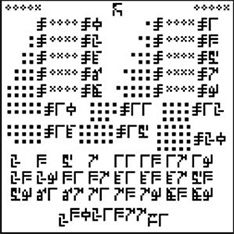
That’s a message. And if the aliens divide 370,967 by 16,129, they will get the number 23. That will tell them, Dumas and Dutil hoped, that the message has 23 pages.
Or maybe not. What if they try to interpret the bits as a kind of speech or music, never realizing that they code for pictures? What if they don’t have vision and have never imagined two-dimensional forms of representation? Or think in polar coordinates instead of Cartesian ones, so it never occurs to them to arrange the bits into squares? Or having done that, what if they can’t figure out its convention of reading left to right, top to bottom? It might drive them crazy. “It’s perfectly conceivable that aliens and humans will represent that same key scientific concepts in such radically different ways that we’ll never understand each other,” Vakoch says.
But any effort to talk to aliens is going to run this risk. Dutil and Dumas essentially threw up their hands and said, “We have to make some assumptions.”
Humans might be rather confused by the first page too. It looks cryptic and eldritch, with all those strange glyphs.
In fact, the first page is extremely simple. Dutil and Dumas took their cue from Freudenthal, who had argued that elementary math is the subject most likely to be mutually intelligible to sapient minds on different planets. “Mathematics is the most abstract subject we know,” Freudenthal had written, “and at the same time a subject that may be supposed to be universally known to humanlike intelligent beings.”
So the first page simply establishes our number system. Its upper half lists the numbers 1 to 20 in three forms: as a group of dots, as binary code, and as a base-10 numeral. The symbol  means “equals.” So the line
means “equals.” So the line  means 2 = 2 = 2. The lower half of the page lists the prime numbers 2 through 89, and the largest known prime as of 1999, which was 23,021,377-1.
means 2 = 2 = 2. The lower half of the page lists the prime numbers 2 through 89, and the largest known prime as of 1999, which was 23,021,377-1.
The glyphs look strange because Dutil and Dumas designed them to be resistant to signal degradation. There is plenty of radio noise in space. A single flipped bit could make an 8 into a 0, or a 1 into a 7. But the glyphs are hard to confuse with each other even if corrupted by noise. As further insurance, the primer was sent three times to each target star so that each copy could be cross-checked against the others. Furthermore, none of the glyphs is a rotated or mirrored image of any other, so the message will still be intact if the recipients construct it upside down or in mirror-reverse. “Part of the genius of the Cosmic Call messages is that they are redundant,” says Vakoch.
Page 2 introduces the basic operators: addition, subtraction, multiplication, and division. Then it dips into fractions and negative numbers.
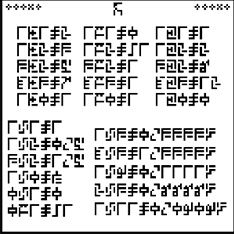
Page 4 introduces the concept of the variable, using a new character,  .
.
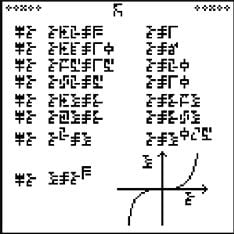
The first line, translated, goes like this:
 X X+2=3 X=1
X X+2=3 X=1
This can be read as, “What is X? X + 2 = 3. X=1.”  is a variable, then, an inquiry. This is one of the most important aspects of the message, since with this symbol it can begin enabling discussions about abstract quantities. At the lower right-hand of the page is a graph with the labels for the X and Y axes.
is a variable, then, an inquiry. This is one of the most important aspects of the message, since with this symbol it can begin enabling discussions about abstract quantities. At the lower right-hand of the page is a graph with the labels for the X and Y axes.
Page 5 introduces diagrams explaining pi and the Pythagorean theorem. Not that they need explaining, because any species that can build a radio receiver will know them, but they can serve as a basis for further communication.
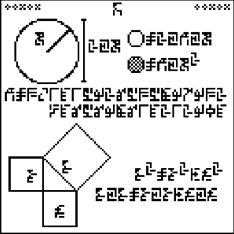
On page 11 the message shows the planets of the Solar system, with Earth identified with a particular glyph,  . This is also used on several other pages in the hope of making it clear by using it in multiple contexts.
. This is also used on several other pages in the hope of making it clear by using it in multiple contexts.
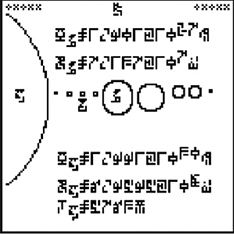
Page 14 specifies the molecular makeup of Earth’s soil, water, and air, using glyphs for atoms defined on page 6 (identifying them by the number of protons and neutrons in the nucleus). It has schematic drawings of mountains and water, labeled with the main components of Earth’s land, sea, and air, including nitrogen 
 (NN), oxygen
(NN), oxygen 
 (OO), argon
(OO), argon  (Ar), and carbon dioxide
(Ar), and carbon dioxide  (COO).
(COO).
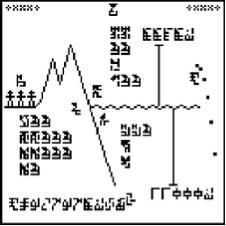
On page 15 the primer helpfully provides a picture of a human male and female.
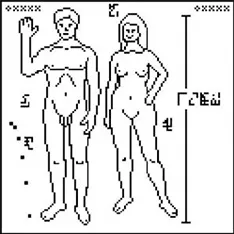
The figures are accompanied by glyphs noting their mass and size, with their orientation in gravity shown by the trajectory of a falling object in the lower left corner. Dutil and Dumas cribbed this drawing from plaques placed on the Pioneer 10 and 11 probes launched in 1972 and 1973.
Aliens might find this page one of the more mysterious ones in the primer. Perspective diagrams are so familiar to humans that we tend to forget they are based on social conventions for representing three-dimensional figures in two dimensions. Color and shading are ignored, for example. It is an open question whether aliens would understand them. One also rather doubts that aliens would understand the lines that signify man’s six-pack and the woman’s hair. They might think that humans have heads topped with chitin, or always wear helmets.
Page 17 shows the nucleotides of earthly DNA.
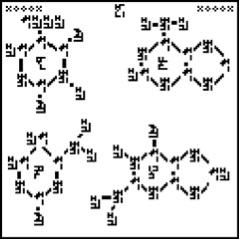
And finally, on the last page, it asks for a reply.
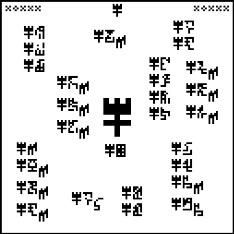
There is a large  glyph at the center – the same “variable” glyph introduced on Page 4. The first two lines on the upper left mean, “What is your mass? What is your size?” (The term for mass was defined on pages 6 and 7 by referencing Avogadro’s number and the mass ratio of the proton and electron.) Here the
glyph at the center – the same “variable” glyph introduced on Page 4. The first two lines on the upper left mean, “What is your mass? What is your size?” (The term for mass was defined on pages 6 and 7 by referencing Avogadro’s number and the mass ratio of the proton and electron.) Here the  glyph is being used to ask questions. It is a touching final page, saying What about you? It is an invitation to a conversation – and it offers a ready-made language in which a reply can be sent.
glyph is being used to ask questions. It is a touching final page, saying What about you? It is an invitation to a conversation – and it offers a ready-made language in which a reply can be sent.
But the Dutil-Dumas primer was just the beginning of the message. It was followed by a medley of other materials—written messages, drawings, and photos from people around the world, many of whom had contributed small amounts of money to support the project. There was also a video by the ABC broadcaster Hugh Downs, pictures of country flags, a message from Sally Ride, David Bowie’s song “Starman,” and quite a bit more. What extraterrestrials would make of all this is hard to say.
The primer was sent at a very slow 100 bits per second to maximize its chances of clear transmission. (A high-end WiFi router can send about two billion bits per second.) The rest was sent at 2,000 bits per second to save time and money. Because of its slow speed, the primer is the part of the message most likely to remain readable after traveling for 50 to 70 years in a medium saturated with interstellar radio noise. It may also be the most likely to be understandable by nonhuman intelligences. It may be, in other words, that the primer effectively is the message.
…
In 1999 no one knew if any nearby stars had potentially habitable planets where a civilization could be living. So the Cosmic Call team did some guessing. Their target list consisted of nine stars that were, among other things, (a) similar to the Sun, (b) visible from Evpatoria, and (c) in the galactic plane. After all, if a target star is uninhabited, perhaps the next star after it will have someone at home. (Zaitsev gives the target list here.)
Today, three of those stars are known to have planets. Hip 43587, also known as 55 Cancri, is 41 light-years away and has five planets. One of them is in the habitable zone, that is, at the right distance from its star for water to remain liquid. However, it’s a Neptune-sized gas giant that couldn’t support life as we know it. But if it has moons, one of them might be habitable. If a moon is large enough, it can have an atmosphere just like a planet. So it’s just conceivable that someone there will get the message in 2044.
16 Cygni is a triple-star system, and one of its stars, 16 Cygni B, has a gas giant that was discovered in 1996 by ground-based telescopes. It, too, might have moons. It spends part of its orbit in the habitable zone, but only part; in the rest of its orbit water would either freeze or boil. It might be that on average the temperature on a moon would stay in the liquid range, making it habitable -- but that’s a long shot. The message will arrive there in 2069.
HD 190360, fifty-two light-years away, has two planets, but neither are in the habitable zone. The message will probably race past them in 2051 unobserved.
The other six stars haven’t been scrutinized for planets yet. The closest star in the target list, Hip 4872, is 33 light-years away, so the signal will reach it in 2036. If anyone there is paying attention, and replies right away, we will get that reply in 2069.
But any realistic person will have to concede that it’s not likely. Time and space are not on humanity’s side. On Earth, uncountable millions of species have gone extinct in the planet’s four-billion year history of life, obliterated by the brutal contingencies of competition, catastrophe, and climate change. Are technological species like us exempt from that rule? No one knows. But we could easily miss neighbors simply because they came and went a million years ago.
Or because they will not emerge until a million years from now. To a planet, a million years is nothing. Proportionally speaking, if Earth was a senior citizen, a million years would be less than a week of its life. Missing a next-door civilization by a million years is like never meeting the love of your life because she moved to your city a week after you left.
And even if someone is home, and has the equipment to listen, they will have to be listening during the four-hour period in which the message sweeps past them. What if their antennas dedicated to SETI are pointing somewhere else that day? Clearly, any truly serious effort at interstellar communication will have to run continuously, and on both ends.
We can but hope.
...
The odds of getting a reply to the Cosmic Call seem remote. But should we be shouting into the cosmos in the first place? Could it bring aliens to our doorstep who want “to serve man” as dinner?
In fact, the National Space Agency of Ukraine, as it was called at the time, was alarmed enough to stop the transmission in 1999 after the message had been sent to the first star on the target list. According to Zaitsev, the agency was rattled by the attention the message was getting from the press. “Such energetic reaction of Western mass media also was an alarming news for Kiev's officers,” he says. In addition, they had been told that the transmissions were “very dangerous for terrestrials and that USA's deep space stations refused to make Cosmic Call transmission.” They pulled the plug. Zaitsev rushed to Kiev to reassure the brass, and the transmissions resumed on June 30, 1999.
The science fiction writer David Brin has expressed strong objections to projects like Cosmic Call. It’s not the act of messaging in itself that Brin objects to. He thinks the risks are probably small and agrees that the benefits of a reply could be immense. But the risk is not zero, he points out. Even friendly contact between cultures on Earth has led to the destabilization of the less-developed one. So consultation and mutual agreement are needed, rather than independent efforts. Brin writes, “But when that risk is also imposed upon our children – all of humanity and our planet – is it too much to ask that we discuss it first?”
The problem with having such a discussion, Brin admits, is that fear might prevail. Given the impossibility of refuting the alarmists, humanity might choose never to send a message again. If every species in the cosmos goes by the same logic, then obviously no conversation will ever get started. But a discussion would also examine the benefits, Brin thinks, and aim for a compromise approach. It would be of profound interest, he says: “Televised worldwide, it could enthrall millions and deal with every topic from physics and biology to history and anthropology -- a win-win that would doubtless benefit SETI as well.”
Richard Braastad, now a writer living in Houston, was the Cosmic Call’s coordinator, responsible for assembling the message and preparing it for transmission. He downplays the risks, pointing out that on Earth developed countries often help people in less-developed ones via efforts like the Peace Corps. “Our motivations as a species are more complex than the simplistic either-or choice between absolute evil and absolute benevolence that seems to dominate debates about the possible moral nature of ETIs,” he says.
…
One might think sending messages to other stars would be a massive, expensive job. No. It isn’t. The Cosmic Call was essentially a crowdfunded hobby project. Chafer estimates that it cost about $50,000 in direct costs, plus another $50,000 in indirect costs such as staff time. Much of the money came from small donations triggered by media coverage. Chafer thinks it took fewer than 20 people, all told, to create the message and send it.
But the drawback of freelance projects like Cosmic Call is that there’s no institution to preserve a memory of them. The message hasn’t been particularly well-archived. (Sadly, Stéphane Dumas died unexpectedly in August 2016.) It would be embarrassing if we got a reply in 2069 and no one could remember what we had sent. All of the websites that had archived it have disappeared, except for an incomplete remnant preserved here by an Internet archive. The only documents that show the primers are PDFs buried on obscure websites. The 1999 primer is here, and both the 1999 and 2003 primers are explained here.
So one of humanity’s most intellectually ambitious interstellar messages, and so far the one most likely to get where it’s going, was written by two people, Dutil and Dumas. There’s a lesson there. If we ever receive a message from another civilization, it may not be from a committee of its august wise heads (or whatever they have instead of heads.) It may not be from their equivalent of the United Nations or United Federation of Planets. A civilization modestly more developed than ours could be using Evpatoria-class transmitters for the local equivalent of high-school science projects. In other words, Earth’s long-awaited first message from aliens, if it ever comes, could basically be from a couple of guys.